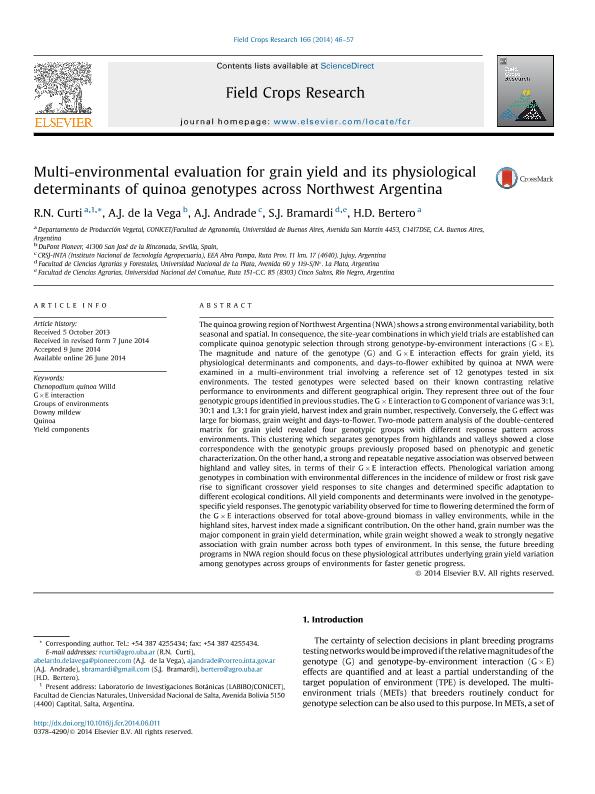Mostrar el registro sencillo del ítem
dc.contributor.author
Curti, Ramiro Nestor

dc.contributor.author
de la Vega, A. J.
dc.contributor.author
Andrade, A. J.
dc.contributor.author
Bramardi, Sergio Jorge

dc.contributor.author
Bertero, Hector Daniel

dc.date.available
2016-08-11T18:56:37Z
dc.date.issued
2014-07
dc.identifier.citation
Curti, Ramiro Nestor; de la Vega, A. J.; Andrade, A. J.; Bramardi, Sergio Jorge; Bertero, Hector Daniel; Multi-environmental evaluation for grain yield and its physiological determinants of quinoa genotypes across Northwest Argentina; Elsevier Science; Field Crops Research; 166; 7-2014; 46-57
dc.identifier.issn
0378-4290
dc.identifier.uri
http://hdl.handle.net/11336/7102
dc.description.abstract
The quinoa growing region of Northwest Argentina (NWA) shows a strong environmental variability, both seasonal and spatial. In consequence, the site-year combinations in which yield trials are established can complicate quinoa genotypic selection through strong genotype-by-environment interactions (G × E). The magnitude and nature of the genotype (G) and G × E interaction effects for grain yield, its physiological determinants and components, and days-to-flower exhibited by quinoa at NWA were examined in a multi-environment trial involving a reference set of 12 genotypes tested in six environments. The tested genotypes were selected based on their known contrasting relative performance to environments and different geographical origin. They represent three out of the four genotypic groups identified in previous studies. The G × E interaction to G component of variance was 3:1, 30:1 and 1.3:1 for grain yield, harvest index and grain number, respectively. Conversely, the G effect was large for biomass, grain weight and days-to-flower. Two-mode pattern analysis of the double-centred matrix for grain yield revealed four genotypic groups with different response pattern across environments. This clustering which separates genotypes from Highlands and Valleys showed a close correspondence with the genotypic groups previously proposed based on phenotypic and genetic characterization. On the other hand, a strong and repeatable negative association was observed between Highland and Valley sites, in terms of their G × E interaction effects. Phenological variation among genotypes in combination with environmental differences in the incidence of mildew or frost risk gave rise to significant crossover yield responses to site changes and determined specific adaptation to different ecological conditions. All yield components and determinants were involved in the genotype-specific yield responses. The genotypic variability observed for time to flowering determined the form of the G × E interactions observed for total above-ground biomass in Valley Environments, while in the Highland sites, harvest index made a significant contribution. On the other hand, grain number was the major component in grain yield determination, while grain weight showed a weak to strongly negative association with grain number across both types of environment. In this sense, the future breeding programs in NWA region should focus on these physiological attributes underlying grain yield variation among genotypes across groups of environments for faster genetic progress.
dc.format
application/pdf
dc.language.iso
eng
dc.publisher
Elsevier Science

dc.rights
info:eu-repo/semantics/openAccess
dc.rights.uri
https://creativecommons.org/licenses/by-nc-nd/2.5/ar/
dc.subject
CHENOPODIUM QUINOA WILLD
dc.subject
DOWNY MILDEW
dc.subject
GROUPS OF ENVIRONMENTS
dc.subject
G×E INTERACTION
dc.subject
QUINOA
dc.subject
YIELD COMPONENTS
dc.subject.classification
Agricultura

dc.subject.classification
Agricultura, Silvicultura y Pesca

dc.subject.classification
CIENCIAS AGRÍCOLAS

dc.title
Multi-environmental evaluation for grain yield and its physiological determinants of quinoa genotypes across Northwest Argentina
dc.type
info:eu-repo/semantics/article
dc.type
info:ar-repo/semantics/artículo
dc.type
info:eu-repo/semantics/publishedVersion
dc.date.updated
2016-08-11T13:58:42Z
dc.journal.volume
166
dc.journal.pagination
46-57
dc.journal.pais
Países Bajos

dc.journal.ciudad
Amsterdam
dc.description.fil
Fil: Curti, Ramiro Nestor. Universidad de Buenos Aires. Facultad de Agronomia. Departamento de Producción Vegetal. Cátedra de Produccion Vegetal; Argentina. Consejo Nacional de Investigaciones Científicas y Técnicas. Centro Científico Tecnológico Conicet - Salta; Argentina
dc.description.fil
Fil: de la Vega, A. J.. DuPont Pioneer; España
dc.description.fil
Fil: Andrade, A. J.. Instituto Nacional de Tecnologia Agropecuaria. Centro Regional Salta-Jujuy; Argentina
dc.description.fil
Fil: Bramardi, Sergio Jorge. Universidad Nacional de La Plata. Facultad de Ciencias Agrarias y Forestales; Argentina. Universidad Nacional del Comahue. Facultad de Ciencis Agrarias; Argentina
dc.description.fil
Fil: Bertero, Hector Daniel. Universidad de Buenos Aires. Facultad de Agronomia. Departamento de Producción Vegetal. Cátedra de Produccion Vegetal; Argentina. Consejo Nacional de Investigaciones Científicas y Técnicas; Argentina
dc.journal.title
Field Crops Research

dc.relation.alternativeid
info:eu-repo/semantics/altIdentifier/url/http://www.sciencedirect.com/science/article/pii/S0378429014001567
dc.relation.alternativeid
info:eu-repo/semantics/altIdentifier/doi/http://dx.doi.org/10.1016/j.fcr.2014.06.011
Archivos asociados
